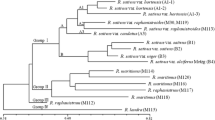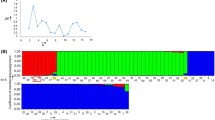Abstract
Trifoliate orange [Poncirus trifoliata (L.) Raf.] is frequently used as a parent in citrus rootstock breeding, but the origin and amount of genetic diversity in germ plasm collections are poorly understood. Most accessions are self-compatible, but produce a mixture of sexual and apomictic seedlings. Variation among 48 vegetatively propagated trifoliate orange accessions was assessed at seven isozyme loci, together with the restriction fragment length polymorphisms (RFLPs) detected by 38 probe-enzyme combinations and the inter-simple sequence repeat (ISSR) markers generated by 11 primers. Isozymes and RFLPs detected few polymorphisms among accessions, although genetic analysis has shown that the common phenotype is heterozygous for four isozyme and at least four RFLP loci. ISSR amplification generated multiple banding profiles with an average of 58 fragments/primer/accession. These fragments were repeatable across DNA samples extracted from different trees of the same accession or extracted at different times, and across separate PCR runs. Seventeen unique marker phenotypes were identified. The 48 trifoliate orange accessions were classified into four major groups based on polymorphic ISSR markers. All large-flowered accessions are in group 4, while small-flowered accessions are in group 3. Many ISSR markers segregated in progeny derived by open-pollination (probably mostly selfing) of a common accession, indicating that these ISSR markers are also heterozygous. Accessions having identical genotypes for a large number of heterozygous markers are unlikely to have diverged by recombination. Thus the limited divergence we detected among most accessions most likely originated by mutation. ‘Monoembryonic’ and ‘Simmons’ differed from other accessions only in the loss of specific markers, indicating that they originated as zygotic seedlings of individuals similar to the common genotype. Three accessions recently introduced from China have relatively different fingerprints with 3–14 unique ISSR markers, and probably represent a much more divergent germ plasm that may be a valuable breeding resource.
Similar content being viewed by others
Author information
Authors and Affiliations
Additional information
Received: 8 August 1996 / Accepted: 21 March 1997
Rights and permissions
About this article
Cite this article
Fang, D., Roose, M., Krueger, R. et al. Fingerprinting trifoliate orange germ plasm accessions with isozymes, RFLPs, and inter-simple sequence repeat markers. Theor Appl Genet 95, 211–219 (1997). https://doi.org/10.1007/s001220050550
Issue Date:
DOI: https://doi.org/10.1007/s001220050550




